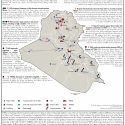 |
 |
Iraq Situation Report: November 2-8, 2016

ISIS is attacking various locations and forces in Iraq in order to find and exploit a seam that can unravel the anti-ISIS Coalition. ISIS launched attacks in Tikrit and Samarra on November 6, targeting Shi’a civilians, including Iranians visiting for a Shi’a holiday. The attacks likely aim to provoke Shi’a militias to carry out reprisals on Sunni populations in order to marginalize Sunnis from the Iraqi Government. ISIS also detonated a Vehicle-Borne IED (VBIED) in Baghdad on November 8. ISIS may hope to unravel political seams that could undermine the legitimacy of the Abadi administration, like it did with the July 3 VBIED which led to the resignations of senior security officials. Some recent ISIS attacks have had success in exploiting these seams: ISIS’s attack on Kirkuk City on October 21 resulted in Kurdish security officials demolishing the homes of Sunni Arabs in response to the attacks, according to November 3 Human Rights Watch report. Although ISIS has hit on the Kurdish-Arab seam in Kirkuk, it has not been able to fracture the anti-ISIS alliance between the Peshmerga and the Iraqi Security Forces (ISF), which continue to make significant gains in eastern Mosul and north and south of the city from November 2 to 8. ISIS will continue to try to exploit seams that can affect the progress of the anti-ISIS alliance in the short-term while hitting seams which keep Iraq’s Sunni population sufficiently disillusioned and victimized by the Iraqi Government in the long-term. Therefore, if ISIS needs to go to ground after it loses Mosul, there are conditions set for a renewed Sunni insurgency, off of which ISIS can rebound.